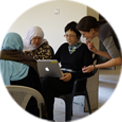Improvisation, Interaction and Iteration in the Evolution of Linguistic Structure: Evidence from Artificial Sign Language Experiments
Simon Kirby
Centre for Language Evolution
University of Edinburgh
There are three distinct mechanisms that drive the cultural evolution of language: improvisation (the spontaneous invention of new communicative solutions without prior convention), interaction (the repeated use of signals for the purposes of communication between individuals), and iteration (the transmission of sets of communicative conventions to a new generation of learners in a population). Using a series of laboratory experiments where hearing participants communicate using only their bodies and no speech, our lab has investigated the different biases that these three processes bring to bear on an evolving language. Specifically, we show that improvisation leads to iconic/natural signals; interaction leads to convergence on communicatively efficient signals; and iteration leads to systematicity. I will argue that the design features of human language are the natural result of cultural evolution in the presence of these three mechanisms, each of which comes to the fore at a different stage in the emergence of language.







